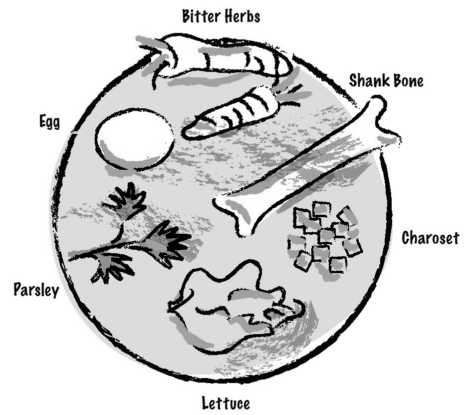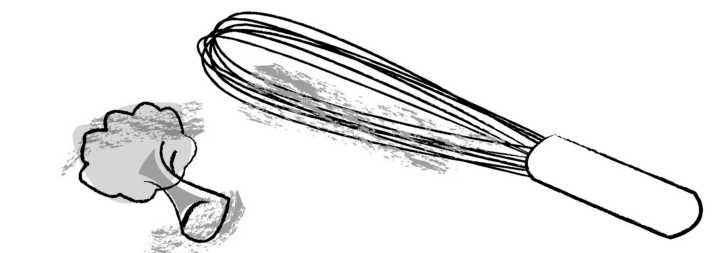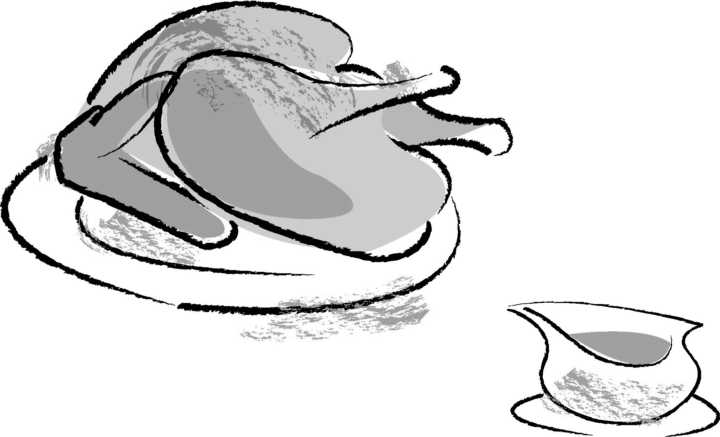Jewish Cooking Boot Camp: The Modern Girl's Guide to Cooking Like a Jewish Grandmother (18 page)
Read Jewish Cooking Boot Camp: The Modern Girl's Guide to Cooking Like a Jewish Grandmother Online
Authors: Andrea Marks Carneiro
Tags: #Cookbooks; Food & Wine, #Entertaining & Holidays, #Special Diet, #Kosher, #Special Occasions, #Religion & Spirituality, #Judaism

"Whoever enlarges on the telling of the Exodus is praiseworthy."
Among all the Jewish holidays, none has a greater direct relationship to food than
Passover. In fact, the central fixture of the Passover table is a seder plate containing
specific foods that are consumed for the sole purpose of identifying with the Exodus of
the Jews from their slavery in Egypt.
Parsley, one of the bitter herbs on the seder plate, represents the bitterness of slavery, while the salt water represents the tears shed by the Jews while in bondage in
Egypt. The foods on the seder plate are physically joined with each diner by their consumption during the retelling of the Exodus in the Haggadah. Haggadah actually
means "telling" and is a fulfillment of the scriptural commandment to each Jew to
"tell your son" about the Jewish liberation from slavery in Egypt, as described in the
book of Exodus in the Torah. (Next time you watch The Ten Commandments, there is
a scene about ninety seconds long in which Moses, portrayed by Charlton Heston,
performs a small portion of the seder before he leads the Hebrews to freedom.)
While the Haggadah is designed to be a "narrative," very little of the classic
Haggadah is devoted to a simple telling of the Exodus story. Instead, the rabbis wove
a variety of activities into the seder event that purportedly serve to highlight the values of the Exodus and enable the participants to "learn by doing." Presently more
than three thousand known editions of the Haggadah exist, and in recent years a
new effort has begun to express the story of the Passover in contemporary terms and
with allusions to current struggles. There have been many textual additions to the Haggadah as well as commentaries on the meaning of the texts and actions over the
ages; still, a basic structure (seder means "order") remains.
Therein lies the rub. It is unusual to find a Jew who cannot recount at least one
seder, normally experienced as a child, as "taking forever before we finally ate."
The reality is that a seder can last as long as several hours and can be as short as
thirty minutes. The length of the "telling" is normally a function of the length of the
Haggadah. Our own experience has been instructive and may assist you in determining how to "tell" of the Exodus.
When we were first married we would normally celebrate Passover at Roz's parents' home, and the full-length Haggadah was the operative version. Normally, somewhere between sixty and ninety minutes were dedicated to the "telling" before we
could begin the "festive meal." The unspoken irony was that there were initially no
children at the seder and all the participants had been "told" the story many times
before. These seders tended to focus on the prayers and songs, sometimes at the
expense of the drama associated with the story of delivery from bondage. This same
seder was repeated for many years, despite the fact that the numbers of those sons
(and daughters) to be "told" were expanding.
As we became the "tellers" of the story, we decided to try some alternatives. One
year we focused almost exclusively on the content and meaning of the seder plate. I
located a wonderful Web site, The Virtual Seder Plate, and I printed out the explanation of each part of the seder plate. I distributed a section to some of our family and
guests, which they read aloud. We learned quite a bit about the objects associated with
a religious observance we had witnessed or performed many, many times before. We
did "tell" the story, but on that particular night we focused on the symbolic nature of
each item. It was a great way to celebrate Passover, and we have done it again on more
than one occasion. On another Passover I had just finished reading Mystic Quest: An
Introduction to Jewish Mysticism, by David Ariel, and we incorporated some aspects of
Kabbalah into our seder.
As our children grew older and we were blessed with the arrival of our own
grandchildren, we finally put our gelt where our mouths were and created our own
Haggadah. As with most things that are on one's lifetime "to-do" list, the anticipation
was much more difficult than the doing. We made a decision to "tell" the story of the
Exodus with more emphasis on the "why" and not the "what." If you have the desire to
make your own Haggadah, the basic outline (which we have provided below), an older
Haggadah that is comprehensive, and access to a computer, you will find that by dedicating a few hours an evening over the course of a week, you will have become "praiseworthy." Begin with the understanding that the seder and the Haggadah consist of the
following segments:
Sanctifying the holiday;
Washing the hands;
Eating the green vegetable dipped in
salt water;
Breaking the middle matzo;
Reciting the narrative;
Washing the hands (before eating
the meal);
Blessing for the bread and the matzo;
Eating the bitter herb;
Eating the matzah with the bitter herb;
Eating the meal;
Finding the afikomen;
Reciting the grace after meals;
Singing Psalms of praise; and
Concluding with the hope that the Exodus
has been told with the appropriate intention.

After that, it is totally in your hands. I used normal search engines and simple
search terms on Google to find more resource information than I ultimately needed
to create precisely what we wanted. I would strongly suggest that when you are creating your own Haggadah, you consider the anticipated changes in the size of your
family (the new members, the relative attention span of all members); their general
personal religious convictions; and their ability to become an unruly mob. Armed
with this knowledge, create your Haggadah with sections that can be utilized or
passed over (no pun intended) at any particular seder. Keep in mind who you are
"telling" the story of Exodus to. Don't lose sight of the scriptural commandment in
favor of scripture. There are a number of Web sites with a lot of Judaic clip-art on
the Internet (some free) that can make your personal Haggadah more pleasing to
the eye and interesting for the younger participants.
If you use your computer and some simple search terms, there are innumerable Web sites that have a lot of information about the Passover holiday. Most of them
also make great suggestions for including young children in the seder (for example, when telling of the plagues that befell the Egyptians, get some plastic animals
to portray the frogs and beasts; ping-pong balls or plastic golf balls for hail; red food
coloring for blood, and so on).
Having had this experience, I strongly encourage you to create your own
Haggadah at the time best suited to you and your family. By the way, at the end
don't forget to include the phrase "Shulchan Orech" or "The Festive Meal." Hopefully
it will become for you, as it has for our family, the segue from your "telling" to a
wonderful family meal with the incredible food found in this book.
It may not be the healthiest option on the table, but it's certainly the tastiest (in Andrea's humble
opinion). This souffle is also a great vegetarian option-it's savory and filling, and even better
reheated with leftovers the next day.
COOKING TIME: 35 MINUTES
1. Preheat the oven to 350°F.
2. Cook the broccoli per instructions on the box and drain well.
3. Grease a 1Y2- to 2-quart casserole dish with cooking spray.
4. Mix all of the ingredients together and pour into the casserole dish.
5. Bake for 35 minutes. Casserole will be lightly browned and firm to the touch.

Most everyone knows how to roast a turkey, but not necessarily how to make a moist and juicy
one. After years of trial and error, and many dry turkeys, we have found a way that seems to work
every time. The secret is roasting the turkey with the breast side down and making sure there is
always chicken broth in the bottom of the pan. We flip the turkey for the last 45 minutes to crisp
the skin, but baste the breast side every 15 minutes as well.
COOKING TIME: APPROXIMATELY 3-4 HOURS
1. Preheat the oven to 325°F.
2. Rinse and dry the turkey. Slice half of the margarine into 5 or 6 pieces; let the rest
soften.
3. Carefully tuck the slices of margarine under the skin of the turkey, pushing them back
near the large breast area. (Be very gentle, as you don't want to tear the skin.)
4. Sprinkle the turkey with salt, pepper, and garlic salt.
5. Pour half of the chicken broth into the bottom of the roasting pan.
6. Place the turkey in the pan, breast-side down.
7. Roast the turkey for 15 to 20 minutes per pound.
8. For the last 45 minutes, turn the turkey breast-side up to brown the top, basting every 15
to 20 minutes. If breast area begins to get too brown, cover the turkey with foil. Continue
to add broth to the bottom of the pan, making sure it is never dry.

Let the turkey sit for at least 30 minutes before slicing. Add salt and pepper to taste if
needed.
